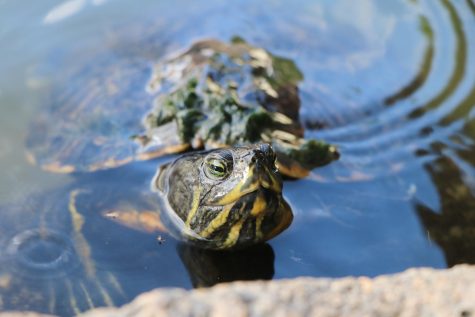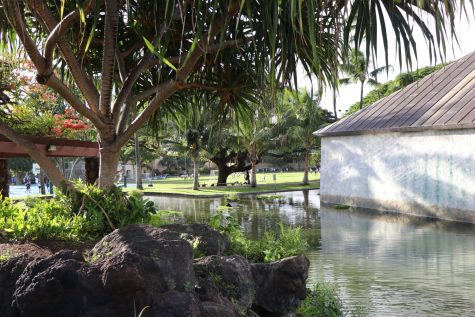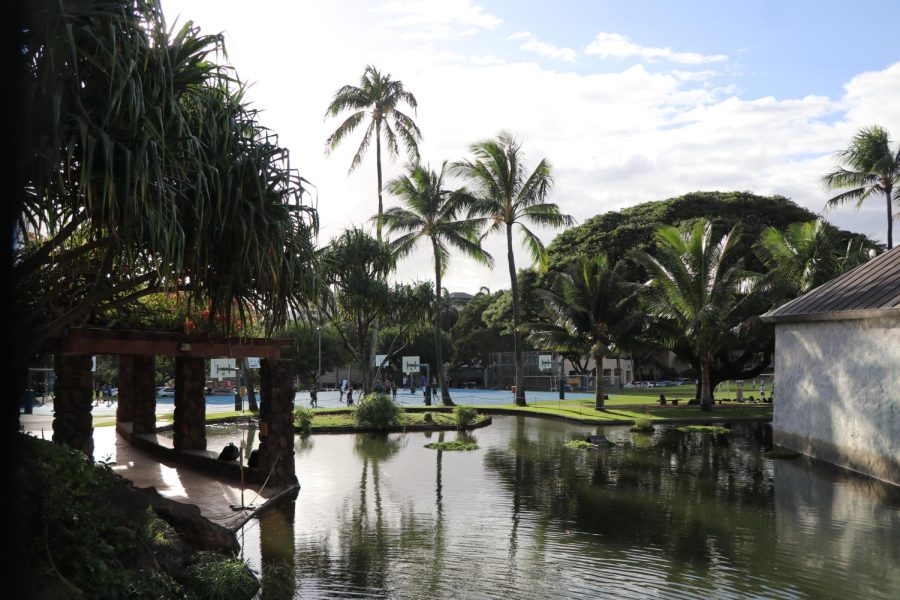Ka Punahou, known to many as simply the lily pond, sits at the center of campus and is considered by many to be the heart of the school. Punahou’s rich history has centered around the ever-changing lily pond since the school was founded in 1841. The lily pond as it exists today is a man-made ecosystem, with its structure, plants, and animals having been designed and installed over time. The pond is home to greenery and an abundance of aquatic creatures. From the koi and red tilapias to the recently added native a’ia’i plants (planted by Outdoor Education), the ecosystem has consistently been supported by the students and faculty of Punahou School.
Mr. Reid Hayes ‘09 was a member of the informal Lily Pond Committee that met to discuss the state of the pond, and he remains involved in discussions with Punahou’s administrators along with other teachers passionate about the lily pond. Hayes is also an AP Environmental Science and Biology Honors teacher. He states that the lily pond is going through a “relatively unhealthy state,” though not at the point of eutrophication. Eutrophication would cause the entire pond to be overgrown with algae, turning it into a “dead zone.” Much is yet to be found out about the lily pond, such as the factors causing fish and plants to die. Lack of nutrients and bacteria might possibly be the provoking factors. An ecosystem is an intricate web of species that all contribute to its success. According to Hayes, the pond is not able to provide and sustain itself as a successful ecosystem should. For example, population growth is not regulated, so much of the aquatic life is imbalanced. Many of the species are just barely surviving, while others, such as turtles, have been rapidly growing in population over the past few years.
History

Turtles and other animals have been introduced to the pond over time. Their populations are largely uncontrolled.
The lily pond has gone through drastic restoration efforts in the past. In the early 1990s, the school began noticing issues with the pond ecosystem. By 1996 a project was launched, using donations from alumni classes to fund the draining and refilling of the pond. Many animals were removed, and all plants had to be relocated to different nurseries. The damage being observed in the lily pond today is possibly the result of actions in previous years, according to Hayes. The lily pond has had a very irregular maintenance routine, and the damage caused might not be something we can fix quickly; restoration work now may take several years to successfully mitigate the issues in the lily pond.
Hayes and many others hope to see improvements and full restoration in the next ten years. Before the COVID-19 lockdown, the lily pond already needed some maintenance, though Hayes noticed its health was declining after he returned. He believes that before the 2000s, the pond was already not in an ideal state. “The lily pond might not be self-sufficient because it is man-made,” Hayes said. Faculty have discussed one possible solution, which is a regular maintenance schedule with a dedicated branch of staff working on the pond. Maintaining a balanced ecosystem is an arduous task that requires decades of work.
Current Projects
Biology Honors teachers Mr. Hayes and Ms. Hirasuna are currently conducting a data collection project with their students, in hopes of informing further research and eventual changes to the lily pond. Their classes are documenting different variables in the pond water including pH, nitrite and nitrate levels, carbonate hardness (KH), and general hardness (GH). This is only the second year of collecting data, though Hayes and Hirasuna hope the project can be continued annually. Many of the experiments are going through trial and error processes as those researching the pond are trying to find the most useful data.

The hala tree in the lily pond is represented in Punahou’s official seal and logo.
All of this data will be analyzed by both Punahou administrators and a professional consulting company. The company, AECOS, focuses on water quality and environmental services. This assortment of student-collected data will aid both groups in their search for the root of the problem.
All around campus, there is chatter among students about the disappearing koi and lilies. Hayes confirmed that many of the koi fish have died over the past years, though he said many people are still working to identify the reason for the decline in what once was an abundant species in the lily pond. The lily pads and flowers, meanwhile, have not been removed. They have decomposed and died, causing a dramatic drop in the foliage in the lily pond.
Future Opportunities?
Many students hope that their own contributions can help to save the lily pond too. A club centered around the lily pond was proposed this year, but was assimilated into the sustainability club. Students have called for volunteer opportunities to assist with lily pond maintenance. Despite the lily pond’s importance as a Punahou landmark, regular maintenance has yet to be achieved. There have been many ideas proposed to the many faculty members concerning the lily pond. Perhaps the real issue at stake is the end goal for the lily pond: should it be turned into a more natural ecosystem, or maintained as a “real” lily pond?


Lynne Meyer • May 1, 2023 at 3:28 am
I don’t know how you can call it a “lily pond” when the pond has no lilies! My class (1974) gave the last senior gift to Punahou: lily pond koi to replace those that had been killed when the chapel was fumigated. After our senior chapel we each took a small plastic bag containing a single fish to the edge of the pond. We then poured 400+ of them in. For years I would return and ask individual koi if they remembered me! If my fish was or is still around, it would now be 49 years old.
I pray for a successful pond recovery and hope that alumni will also be able to contribute to pond renaissance.